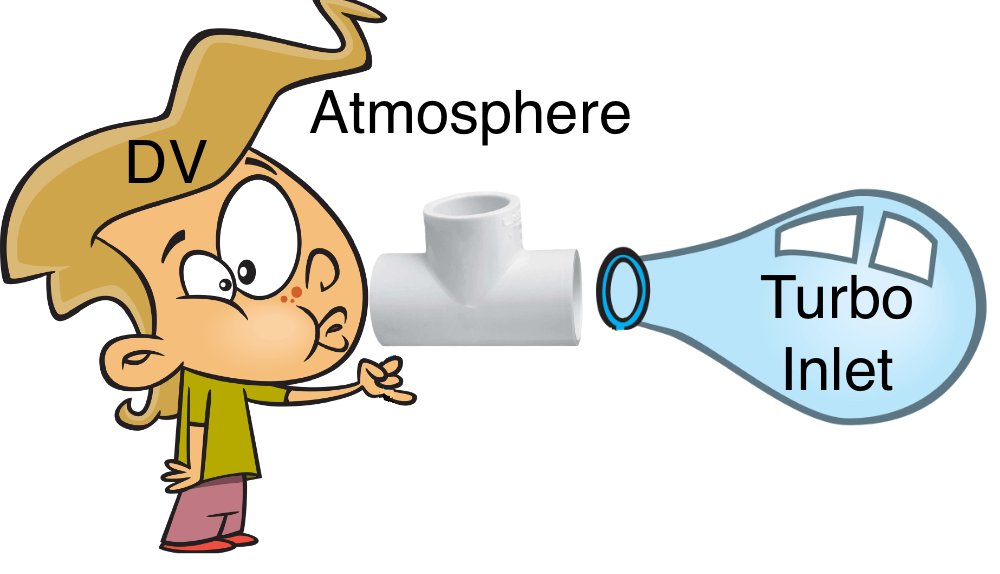
A belief that is occasionally stated about diverter valves (DV) versus blow-off valves (BOV) goes something like this – “A diverter valve is better because air is recirculated.”
Justifications for this are along the lines of:
Belief 1) The turbo won’t lose as much pressure between shifts because air is being recirculated back into the turbocharger.
Belief 2) The turbocharger builds boost faster after a shift because air is being recirculated back into the turbocharger.
Both beliefs presume pressurized air released by the DV will increase the pressure inside the turbocharger inlet. This is incorrect.
To illustrate this concept in action, below is an analogy.
The person’s lungs are the charge piping and their mouth is like a DV (or BOV). When they exhale out their mouth it is like the DV/BOV venting air from the charge pipes.
The balloon is the turbocharger inlet, air is traveling into it.
Note: The analogy is a little off here because the turbocharger pulls air in, whereas the balloon has air forced into it, but this won’t change the point being made because the air movement is a result of pressure differences.
The tee represents the turbocharger compressor cover. The DV is attached to it and the three branches join the DV with the turbo inlet and to the atmosphere (via the airbox).

Normally, the DV is shut and the Turbo Inlet pulls in air from the Atmosphere.
What the “DV is better” proponents are suggesting is that when the DV opens (the person blows into the tee), the Turbo Inlet is pressurized (the balloon is inflated), even though there is an unimpeded path for air to travel out into the open Atmosphere, (backward through the air filter).
To prove to yourself how effective this is at pressurizing the turbo, try this experiment. Pick up a PVC tee from a hardware store and cover one end with the opening of a balloon. Blow into one of the two branches of the tee that are open – your choice, either will work. Leave the other branch open to the atmosphere. Time how long it takes for you to inflate the balloon.
Bypass valve operation explained:

What is happening here is, the turbocharger pulls in air from the Atmosphere by creating a vacuum at the Turbo Inlet.
Air moves from an area of higher pressure to lower pressure, so with a lower pressure area at the Turbo Inlet, it is pulling air in from the Atmosphere when the Bypass Valve (DV/BOV) is closed.
When the Bypass Valve (DV) opens, higher-pressure air from the charge pipes moves into the low-pressure area in front of the Turbo Inlet. The Turbo Inlet draws in some of this air, partially validating the belief, but the DV-sourced air replaces that being drawn in from the Atmosphere.
Once the demand for air from the Turbo Inlet is met, excess pressurized air coming from the DV moves to the lowest pressure area, which is now out of the airbox to the Atmosphere.
Result:
A Diverter Valve will not affect the turbocharger operation differently than a BOV.
The BOV vents to the Atmosphere resulting in the Turbo Inlet drawing air 100% from the Atmosphere.
When a DV is used the Turbo Inlet draws a mixture from the Atmosphere and recirculated air from the charge pipes, but any excess pressurized air, beyond what the Turbo Inlet needs (determined by the amount of vacuum at the inlet), will escape to the Atmosphere.
The excess pressurized air will not move into the Turbo Inlet (inflating the balloon) when it can escape into the Atmosphere.

The real problem with a BOV is when there is a flow meter that has already measured the air that is finally vented to the atmosphere. On an ea888.3 this is not a problem, on other engines it is different…
My mk5 (2007), ea888.2?, and generally most of that generation had a Mass Air Flow Sensor that depended on the closed loop (of a diverter valve). As EA888.2 had already metered the air, the ECU needed that amount to run smoothly.
Today, I really don’t see any operational difference between the earlier MAF and my Mk7.5’s manifold intake pressure (MAP) sensor.
But the MAP allows you to use either a diverter or blow-off.